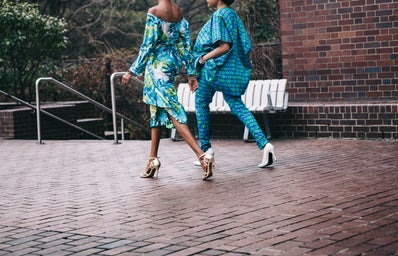On Thursday, after Marc Jacobs closed out fashion week with a highly controversial show, many took to social media to express their disapproval of the collection. The designer received backlash not about the metallic pants and ruffled skirts, but rather an atypical accessory: the hair.
Almost all of the models on Jacobs’ runway sported faux dreadlocks, hand-dyed and hand-rolled by an Etsy seller and her daughter from Florida. The dreadlocks were custom-made for Marc Jacobs and were comprised of 12,500 yards of yarn. A Twitter debate has been going on since they appeared on the runway, and it doesn’t show any signs of stopping. The question of the moment: is Jacobs’ use of faux dreadlocks cultural appropriation, or is it merely “creative inspiration” as Jacobs seems to think?
First, some background information as to how Jacobs actually came up with the idea. Three months prior to his fashion week show, Jacobs was inspired by the multicoloured dreadlocks of the director and transwoman Lana Wachowski, who also happens to be the face of Jacobs’ Spring/Summer 2016 campaign. Jacobs’ eureka moment started a chain of events that eventually led him to Jen, also known as @DreadsbyJena on Etsy. They started working together to create the dreadlocks seen on the models including Kendall Jenner, Gigi Hadid, Karlie Kloss and Adriana Lima to name a few. 300 different shades were used in the making of the dreadlocks.
Once the show was over, Jacobs was expected to talk to insiders and reporters as he usually does after a fashion show, but on Thursday, no one from the press was admitted backstage. By the end of the day, Jacobs’ use of dreadlocks had already fueled a debate. A Twitter user wrote: “An unknown black man/woman has dreads, it is assumed they smoke and/or are unprofessional. Marc Jacobs has a model with dreads, it’s boho chic.”
“… He got the dreads from a white woman, got inspiration from a white woman, and then put the dreads on a slew of white women. He just made it very clear that he does not care about black people or their struggles or their culture. He just does not care, and shame on all of the people who worked on that show and walked in that show,” commented another Internet user under the Nylon Magazine article.
Jacobs addressed the condemnations via Instagram with an answer that severely misunderstands the sensitivity of cultural appropriation: “And all who cry ‘cultural appropriation’ or whatever nonsense about any race of skin color wearing their hair in a particular style or manner – funny how you don’t criticize women of color for straightening their hair. I respect and am inspired by people and how they look. I don’t see color or race – I see people. I’m sorry to read that so many people are so narrow minded…Love is the answer. Appreciation of all and inspiration from anywhere is a beautiful thing. Think about it.”
Fashion Week is now over, but Jacobs’ response is still resonating in many ears. His lack of understanding of how he might have hurt people’s feelings is typical of today’s cultural appropriation under the guise of “creative inspiration” and “self expression.” The perception surrounding dreadlocks and many other cultural values is mostly shaped by influential figures in media who insist on not being sensitive towards the issue, which earns a greater condemnation in itself.
Click here to watch the whole show.
Information obtained from:
http://nymag.com/thecut/2016/09/marc-jacobs-spring-2017-models-wore-etsy-dreadlocks.html
http://nymag.com/thecut/2016/09/fashions-great-appropriator-turns-to-rave-culture.html
Cover picture obtained from:
http://nymag.com/thecut/2016/09/marc-jacobs-spring-2017-models-wore-etsy-dreadlocks.html

